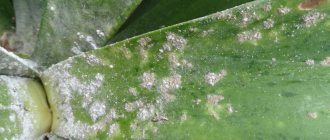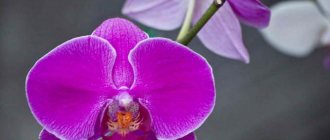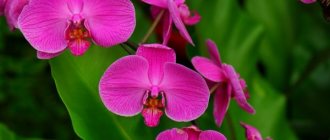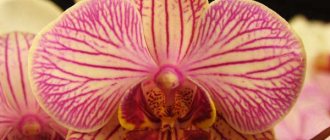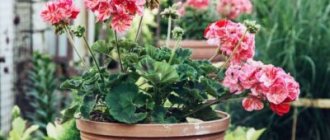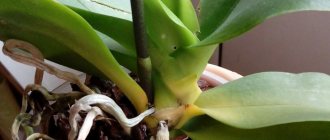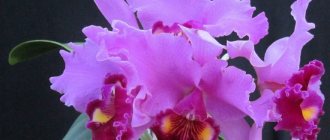Cambria needs care no less than other types of orchids. But the first thing every gardener should understand is that Cambria is the conventional name for all orchid-type hybrids. The purpose of creating such plants is to produce new, less demanding flowers to care for. It is worth noting that the varieties called Cambria are excellent for home growing. The most popular varieties of these hybrids are: “colmanara”, “beallara”, “burrageara”, “miltassia”, “odontioda”, “brassidium” and others.
Origin and description of the Cumbrian orchid
The Cambria orchid is not a single species of plant. The name is rather a commercial one, uniting hybrid species, in the creation of which three or more genera of the oncidium group were used. Nevertheless, each flower has its own name - for example, the name of the scientist who created this or that hybrid.
Cumbria's orchids are stunning in their beauty and diversity
A common feature of hybrids is the sympodial (shoot) type of growth. Cambria has oval, round or ovoid pseudobulbs. They are also called false bulbs. Their main task is to accumulate nutrients to help the plant survive extreme conditions. The more false bulbs, the healthier the Cambria and the more luxuriant the flowering.
Each pseudobulb produces up to 3 leaves. They are painted dark green, narrow and long in shape - up to 50 cm. The central vein is clearly defined.
Unlike other orchids, which have a powerful root system that can hold the plant on the carrier, Cambria's roots are very thin and easily vulnerable.
Cambria is capable of throwing out several flower stalks at the same time. There are dozens of buds on one flower arrow. They are not all revealed at once. The sizes of flowers, varied in shape, range from 5 to 10 cm. They can be white, yellow, burgundy, cream, pink. As a rule, Cumbrias bloom several times a year.
Cambria blooms several times a year
Such plants are not found in nature. They were created exclusively for indoor floriculture. Cumbrias are unpretentious and adapt well to environmental conditions. These are perhaps the most undemanding representatives of the Orchid family. Therefore, for beginning gardeners who are in love with orchids, Cambria is an ideal option.
When buying Cambria in a store, choose a specimen with several pseudobulbs. A plant with one false bulb is usually not viable.
Hybrid species
- Colmanara is a hybrid of Miltonia, Odontoglossum and Oncidium. A long vertical peduncle, appearing at the moment of ripening of a young false bulb, is crowned with 5 or 20 flowers. The colors are dominated by yellow and red. Flowering duration is up to 8 weeks. Popular varieties: Wildcat Bobcat, Wildcat.
- Vuilstekeara is a hybrid bred by crossing Odontoglossum, Cochlyodes and Miltonia. On long and graceful peduncles there are from 5 to 20 flowers, mainly in pink, yellow or red. The flowering period is from late winter to early summer. Duration - up to 2 months. The species is represented by numerous varieties, including: Linda Isler “Red”, Yokara Perfection, Melissa Brianne “Kai, s Choice”.
- Burrageara is a complex hydride, the parent forms of which were Miltonia, Cochlioda, Odontoglossum and Oncidium. It is distinguished by its sophistication: several flowers are collected in inflorescences. The coloration is dominated by combinations of yellow and red tones. Flowering occurs in winter. The smell of such an orchid is reminiscent of a rose. Varieties: Stefan Isler, Stefan Isler “Living Fire”, Nellie Isler “Swiss Beauty”.
- Beallara is a complex hybrid obtained by crossing 4 species: Brassia, Miltonia, Odontoglossum and Cochlioda. The flowering period falls in the middle - end of summer. The graceful flowers are cream-colored with dark spots or white-pink-purple shades. Among the large number of varieties, the following stand out: Peggy Ruth Carpenter “Morning Joy”, Marfitch Howard, s Dream, Tahoma Glacier “Ethan”, Patricia Mc Cully.
- Degarmoara is an intergeneric hybrid of Miltonia, Odontoglossum and Brassia. It has flowers of various shapes and colors up to 10 cm in size. Some of these orchids have a pleasant aroma. The plant blooms all year round. Varieties: Flying High, Winter Wonderland “White Fairy”.
Photo gallery: Flower varieties
Wildcat Bobcat is one of the most popular varieties of the Colmanara species
Vuilstekeara blooms from winter to summer
Burrageara is characterized by yellow and red shades of petals
Beallara is a complex hybrid created from four species
Winter Wonderland “White Fairy” - an exquisite variety of the Degarmoara species
Botanical characteristics
Structure
Plant of sympodial type . It has more than one growth point. There may be 10-15 of them. Less than three is undesirable. There may even be problems with flowering.
Several pseudobulbs . The more there are, the better. For the plant and for you. Burragear will not bloom if there are less than three of them. And flower stalks. With bright and beautiful flowers.
Mature plant height
It is easier to determine the height of an adult plant by looking at the peduncle when staking it. Tilted is more difficult to measure. The leaves are laid out to the sides in the container.
There can be up to three flower stalks at the same time. Height 30-40 cm.
Maximum peduncle length
Peduncles grow up to 40 cm. Each of them has up to 15 flowers. If you see them blooming , you somehow don’t want to take a ruler. And 3-5 cm more or less does not matter.
Diameter, flower shape
There are few flowers in inflorescences. The five petals and the prominent lip are quite large. 6-7 cm in diameter. But they also have a pleasant aroma .
Table: Conditions for maintaining a house
| Season | Lighting | Humidity | Temperature |
| Spring | Even on the north side, Cumbria will do well. To bloom more luxuriantly, Cambria needs diffused but bright light, so the optimal place for it would be a windowsill on the west or east side. A south-facing window with more light than others is also ideal. In spring and summer, the plant should be hidden behind a curtain from the bright sun. This is especially true for hybrids with thin and soft leaves. | Cumbria is not so demanding on the level of air humidity. 25–30% is a sufficient indicator. But during the growth period of young pseudobulbs, the humidity in the room should be raised to 40–50%. If the temperature in the room with the plant does not exceed 18°C, then you should not additionally moisten the flower. In the summer heat and with the central heating running, you can spray the air around Cumbria or place the pot on a flat plate with moistened filler. You need to spray the flower very carefully and only with a fine spray. Do not allow water to flow over the orchid - this can lead to rotting. Placing the plant under the shower is strictly prohibited! | Cambria is a lover of moderate temperatures. Hybrids feel good at 15–25°C. At very high temperatures, Cambria may stop growing. Therefore, preference should be given to a cool room rather than a warm one. In such conditions, the plant develops better. |
| Summer | |||
| Autumn | During the cold season, Cumbria needs to be provided with additional lighting. | Winter temperature ranges from 16 to 18°C. | |
| Winter |
In summer, the flower feels great in the fresh air. In the garden or on the balcony, a secluded place, protected from wind, rain and direct sunlight, is suitable for Cambria. In indoor conditions, the flower requires good air circulation, but is afraid of drafts.
Bright diffused light is essential for Cumbria
History of the creation of the hybrid
Your desire to purchase an orchid will definitely lead you to Burrageara. They are precisely included in the amazing species of Cumbria :
- Brassidium;
- Miltassia;
- Velstekear;
- Colmanara;
- Beallara;
- Miltonidium;
- Odontioda.
The Burragear Orchid is a hybrid created specifically for growing at home.
This hybrid is created for the conditions of apartments and houses. These are the plants that were used to create it :
- Cochlioda;
- Miltonia;
- Odontoglossum;
- Oncidium.
It was named after the American orchidist Albert Burr. And registered in 1927. Very often, experts use it to obtain new beautiful hybrids .
Home care secrets
How to water the soil correctly?
Cambrias are not as moisture-loving as other orchids. The plant should not be over-watered. The refined root system of Cambria is extremely sensitive to stagnant water and can die very quickly. Therefore, water the flower only after the substrate has dried, especially in the middle of the pot. But this does not mean that you can forget about Cumbria for a long time. If the pseudobulbs begin to wrinkle, it means the plant has used all its accumulated reserves and needs urgent watering. The mode is:
- in summer - every 6–8 days. When it is very hot, the period between moisturizing is reduced;
- in winter, if the heating system is not yet working, and it is already cool and damp outside - once every 10-14 days.
The ideal watering method for Cambria is to submerge the pot 1/3 in water. In summer, the plant is saturated with moisture in 20 minutes; in winter, this value is reduced to 5 minutes. Use only clean, well-settled or filtered water for irrigation or immersion.
Is it worth adding fertilizer to the substrate?
Cambria should be fed very carefully due to its sensitive root system. Fertilizers are usually used for orchids, but they are diluted with more water than required. Excessive amounts may burn the plant's roots. The fertilizing period lasts from March to September, the optimal frequency is 1–2 times a month.
Some gardeners prefer foliar feeding, using a very weak fertilizer concentrate.
Feeding stops when flowering begins. The useful substances accumulated by the pseudobulb will be quite enough for this period.
Main features of flowering
Period
- The apple tree blooms in May. So many songs!
- Our orchid does not have such an exact date. They also bloom in winter;
The Burrageara orchid delights with its flowering all year round. - One example. We bought it blooming in May. In August, flowers bloomed on another peduncle;
- And for other gardeners they bloom most intensely in winter;
- Conditions of detention decide a lot;
- And in the summer it delights with its magnificent flowers .
Duration
It blooms in summer. And it usually blooms for the New Year tree. Maybe more often. All this continues for a month or two.
Stimulation
Take care of the difference between night and day temperatures. So that this difference is larger (at least 6-8 degrees). This is one of the main factors for its flowering. Water less often.
Common Problems
Table: Why does a flower grow like a ladder, leaves turn yellow, and so on - mistakes of gardeners
| Signs | Cause | Elimination |
| Cambria's pseudobulbs have begun to wrinkle, and the roots may have dried out. | Insufficient watering. |
|
| Cambria began to grow like a ladder. | Not enough space in the pot. | The plant needs replanting. |
| Weeping spots appear on the leaves. | Frostbite. |
|
| The pseudobulb cracks. | A combination of cold air, poor lighting and frequent flooding of the substrate. | Raise the temperature in the room, move the plant to a light source, water correctly. |
| The leaves turn white, the pseudobulbs thicken and change color. | Excess fertilizer. |
|
| The leaves began to turn yellow. | Excess light. | On sunny days, Cambria needs to be shaded. |
| Young leaves grow like an accordion. | Insufficient air humidity. | Increase the air humidity around the plant using available methods. |
| Anthracnose is a fungal disease that causes brown spots on leaves and pseudobulbs. Over time, they form black concave areas with a yellowish coating. | The plant was subject to waterlogging for a long time. |
If the plant is too damaged, unfortunately, it cannot be saved. |
| Pseudobulbs become watery. |
Photo gallery: signs of improper plant care
Pseudobulb begins to wrinkle during prolonged drought
When Cambria begins to grow like a ladder, this indicates that it is cramped in the pot
Cracking of the pseudobulb occurs due to too low air temperatures and during prolonged flooding
With excessive use of fertilizers, the pseudobulb thickens and changes color
When the air is excessively dry, Cumbria leaves grow like an accordion
When the soil is waterlogged, the pseudobulb becomes watery. Anthracnose may occur
This is what a plant looks like when exposed to cold.
Landing
Priming
Small and medium fractions of the bark of coniferous trees are the main components for creating soil :
- Add peat;
- Charcoal;
- Perlite and pieces of foam;
- And also good drainage from expanded clay.
In a specialized store you will be offered more than one option for soil composition .
Attention! Flower growers advise caution when adding coconut shavings and sphagnum moss at home.
Optimal capacity
Many forms of container containers are suitable for planting . But transparent pots are very convenient:
- You can easily control the condition of the roots and soil . Including humidity;
- And you will be able to make decisions accurately : Watering already?
- Or wait a little?
Technology
The roots are fragile . It needs to be examined very carefully. In soil from the store, they can be closely intertwined with sphagnum moss. It is better to remove it carefully. These fragile roots grow directly into the fractions. Especially coconut ingredients and sphagnum moss. Even in clay pots.
Planting stages:
- Choose the right containers for plants ;
- Choose the best soil option for them;
- Ensure good drainage : Made of expanded clay;
- Shellweed;
- Or small pebbles.
Please note! Do not bury the plant. It should just come out of the pot.
Transfer
They can survive without a transplant for 2-3 years. The reasons for transplantation may be :
- Soil condition . No matter how hard you try to keep it in good condition, it becomes unusable. Salinity is not good for the orchid;
- The plant has grown : It has grown a sufficient number of pseudobulbs;
- They seem to be trying to crawl out of the pot;
- He needs to be seated.
Reproduction of Cumbria
Cambria is propagated by dividing the bush. If the plant becomes cramped in the old container, then when replanting the bush is divided in such a way that each part has at least three pseudobulbs. The procedure is carried out carefully, trying not to damage the roots. The wounds and cuts are sprinkled with crushed coal and dried. Then the separated material is planted in a bark substrate and not watered for a week. The first feeding is carried out at least a month later.
The Cumbria bush is divided very carefully
Most common colors
The variety of combinations of red and yellow colors is the signature color of Burrrageara . But not only these colors.
Burrageara Jimbo Swarm.
Burrageara Pacific Go.
Varieties of Colmanara with photos and names
Colmanara Wildcat or Wild cat Colmanara Wildcat
Colmanara Wildcat 'Green Valley' photo
This is a whole series of hybrids, an outstanding achievement of breeders. The color scheme of petals, sepals and lips is yellow. An ornament in the form of stripes, spots and dashes of burgundy color complements the picture. The lip is large in size and has a bizarre shape. The inflorescence consists of 15-20 corollas. The pleasant aroma is more intense at dawn or sunset.
Colmanara Wildcat 'Yellow Butterfly' photo
There is a variety called Colmanara Wildcat Bobcat or Lynx. The flowers are dark cherry in color and appear almost black. A thin yellow edging adds a “cat-like” mystery. The large two-lobed lip is equipped with a bright growth. The aroma is very light.
Colmanara Black Cat Colmanara Wildcat 'Black Cat'
A very popular variety is Colmanara Wildcat 'Black Cat' with rich dark burgundy tones and a velvety surface of the petals. The tips are slightly colored yellow, the centers with white and yellow edges.
Colmanara Tropic Jungle Colmanara Tropic Jungle
The structure of the inflorescence resembles a radish: on a high peduncle, branches with corollas extend in different directions. Such heaviness often requires support. Colmanara Tropic Jungle's color palette represents a whole extravaganza of colors. Includes white, red, yellow, brown, pinkish shades. A large white-red lip with a fleshy growth attracts attention first of all. Long flowering coupled with a delicate aroma “tempts” you to place the plant in your home.
Colmanara Masai Red Colmanara Masai Red
The orchid is a record holder, since up to fifty corollas bloom simultaneously on the flowering stem. Sepals with petals form a five-pointed star shape, their color is brown-burgundy with darker spots. The large and prominent lip “burns” with a bright red color. The diameter of the flower is 7-8 cm. The lanceolate leaves are light green in color and add a bluish tint to their sophistication.
Colmanara Masai Splash Colmanara Masai Splash photo
There is a variety of Colmanara Masai Splash, in which the deep red lip is decorated at the bottom with sloppy white blots.
Soil for burrageara
These orchids are grown in pots. To plant the crop, you can use crushed coniferous tree bark mixed with sphagnum and peat.
To make the soil more loose, you can add small pieces of polystyrene foam to the mixture. The plant will also grow well in soil with a mixture of coconut chips.
General information
Pseudobulbs are small, ovoid, slightly flattened and ribbed. , light green leaves
To grow a peduncle 1.2 m long and open the first buds, the plant needs about 2 months . The paniculate inflorescence has from 10 to 40 corollas.
The colors of the sepals and petals are various shades of yellow and red. Often, additional decorations are attached to the rich color: spots and stripes of contrasting colors. The enlarged lip stands out against the background of other elements.
The appearance of a second peduncle immediately after the end of the first flowering is a common occurrence. Moreover, subsequent flowering is no worse than the previous one. On the contrary, the number of buds may increase. Lush flowering is accompanied by a wonderful fragrance.
Colmanara blooms most often in the spring . period lasts 1-3 months .
Common diseases, their treatment and prevention
Plant pests: spider mites, thrips, aphids
You are not the only one who has your eye on a good plant . And there will be pests. This is also a spider mite. And thrips. And aphids. And scale insects. They are not immediately detectable. Even with careful daily inspection.
What is highly advisable to do :
- Soap solution. Start there;
- Or maybe you will have to use Fitoverm with Actellik. If you didn’t manage to detect it in time, and there are a lot of pests on the plants. And periodically.
Fungal infections
Carefully inspect the plant when purchasing. If you find any tubercles or various spots on the leaves, then hold off on purchasing. A closer look at it may reveal other flaws.
If these are infections, refuse to purchase !!! Not only that, you cannot always save a damaged plant, even with experience and knowledge. You can infect other pets.
Bacterial rot
This fully applies to bacterial rot. If this happens to your plants :
- Cut off all rot and affected areas. Sterile instruments;
- With subsequent treatment of sections with activated carbon . Zelenka;
- And a mandatory transplant with a change of soil.
